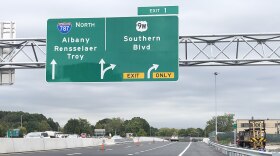How can Albany best utilize $400 million in state funding? Hundreds of business leaders, residents, and government officials gathered at the Capital Center to provide their input.
As part of the $400 million that Governor Kathy Hochul included in her executive state budget to help revitalize Albany, $200 million goes directly to the Championing Albany’s Potential initiative to plan and implement specific projects.
On Wednesday, the initiative’s leaders held a workshop in which hundreds of people began the brainstorming process and discussed their views on the state of Albany and how the city can be improved.
Lukee Forbes is a 31-year-old Albany resident and the executive director of We Are Revolutionary – an organization dedicated to addressing adverse childhood experiences.
“I came out here because I kind of figured that we would be talking about things to do in Albany, without people in Albany talking about those things,” Forbes said.
Forbes was previously incarcerated for his involvement in an assault in Washington Park when he was 15. Since his release, the activist and political candidate has worked for community-focused organizations to address matters of social justice.
Housing affordability is at the top of his list.
“It seems as if they forgot that people live in Albany, we keep seeing the development of these one-bedroom studio apartments but Albany is a family city, you have really big families here,” Forbes said.
In a live poll, respondents were asked to rank which community benefits they would want to see come out of downtown growth. Out of seven rankings, the top three were housing affordability, improved public safety and neighborhood-serving businesses.
Empire State Development and MIG – a planning, design and environmental consulting firm that has worked on projects throughout the country – are heading the strategy development.
MIG’s Director of Economic Development, Ben Margolis, said during a presentation that downtown growth will ripple outward, ultimately benefitting the entire city.
“But only if it’s bold and only if it’s intentional,” Margolis said.
Margolis said Albany needs to attract more people to the city and reuse space that is already available.
“Nationwide, downtowns are also evolving, today’s most successful and resilient are moving from business districts to mixed use urban neighborhoods full of residents and families that want to walk out their doors to shops, restaurants, cultural offerings, recreations, schools, work. And the reason they are doing this is because they have to,” Margolis said.
But Forbes worries that the initiative will prioritize attracting a new population rather than improving conditions for residents that already live in the city.
“It seems like their main focus is one attracting a whole new resident to Albany and when we’re trying to attract a new resident to Albany you typically price out the ones that live there,” Forbes said.
But not all attendees share Forbes concerns.
Tony Iadicicco is the Executive Director of the Albany Center Gallery. He says he is excited to see the plan and its implementation.
“I think everything is possible if people work together and if there is a plan or a vision to try to do as many things at once, I think that is what is going to help. It will also help with job creation. It will cover a lot of things that they discussed as far as housing, if people get jobs than they can afford things,” Iadicicco said.
Iadicicco wants to see the city’s arts, culture and community soar.
“I think if arts, the culture and the community can actually all thrive everybody else is also going to thrive,” Iadicicco said.
In addition to the $200 million to develop downtown more broadly, the $400 million in state funding includes up to $150 million to help transform cultural centers, such as the aging New York State Museum.
Ronald Symansky grew up in the city and lives in a house built by his great-grandfather.
Symansky wants to see a lively, dynamic downtown that feeds the rest of Albany.
“When I was younger and through college, Lark Street was a significant destination and there is still a little bit going on on Lark Street but its not like it was when I was younger,” Semansky said.
Elizabeth Gaudet has lived in the city for 67 years. Gaudet says she wants increased vibrancy and community engagement.
“This group that is leading this particular exercise seems to know how to do it, so we just have to tap into it and stay engaged,” Gaudet said.
But she says Albany is worse off than it was 67 years ago.
“But I believe that the potential is very present and we just have to seize it, we have to make it happen,” Gaudet said.
According to Margolis, the project is expected to go through three phases over the next six months.
First, MIG will develop criteria for investments, then filter, prioritize and bundle those investments and finally develop a strategy for implementation.
Residents interested in participating in and seeking updates on the process can sign up for alerts online.




